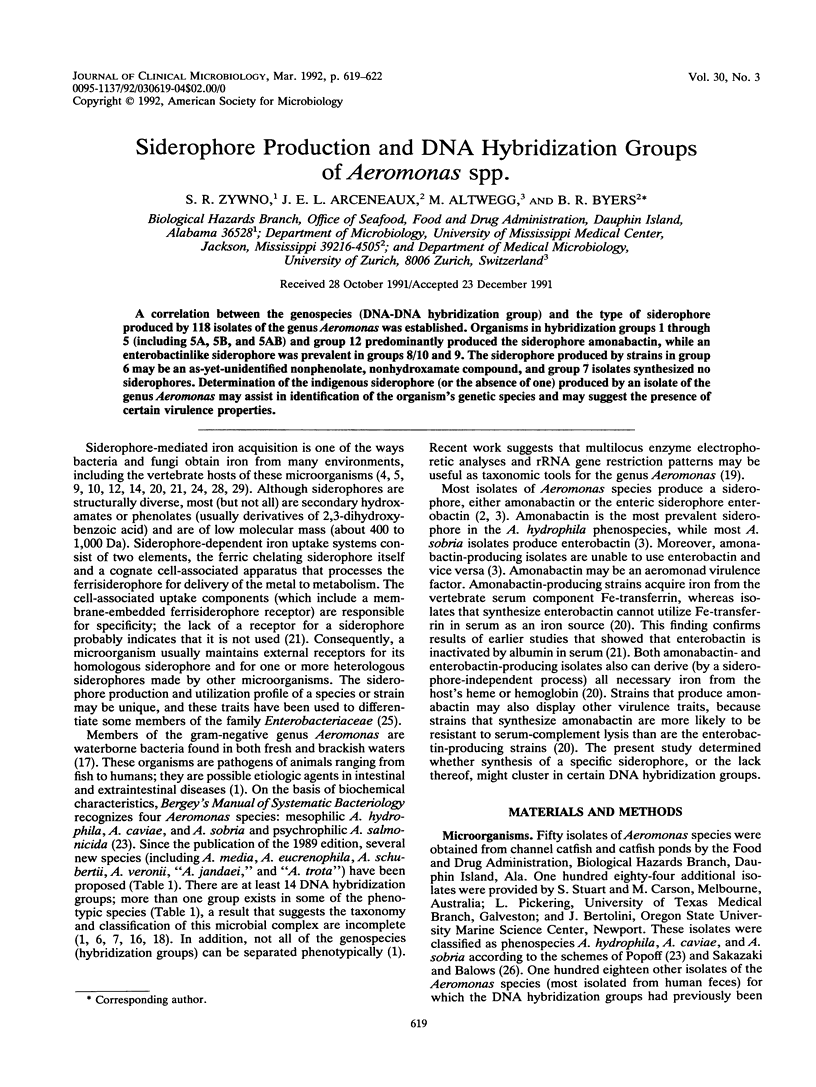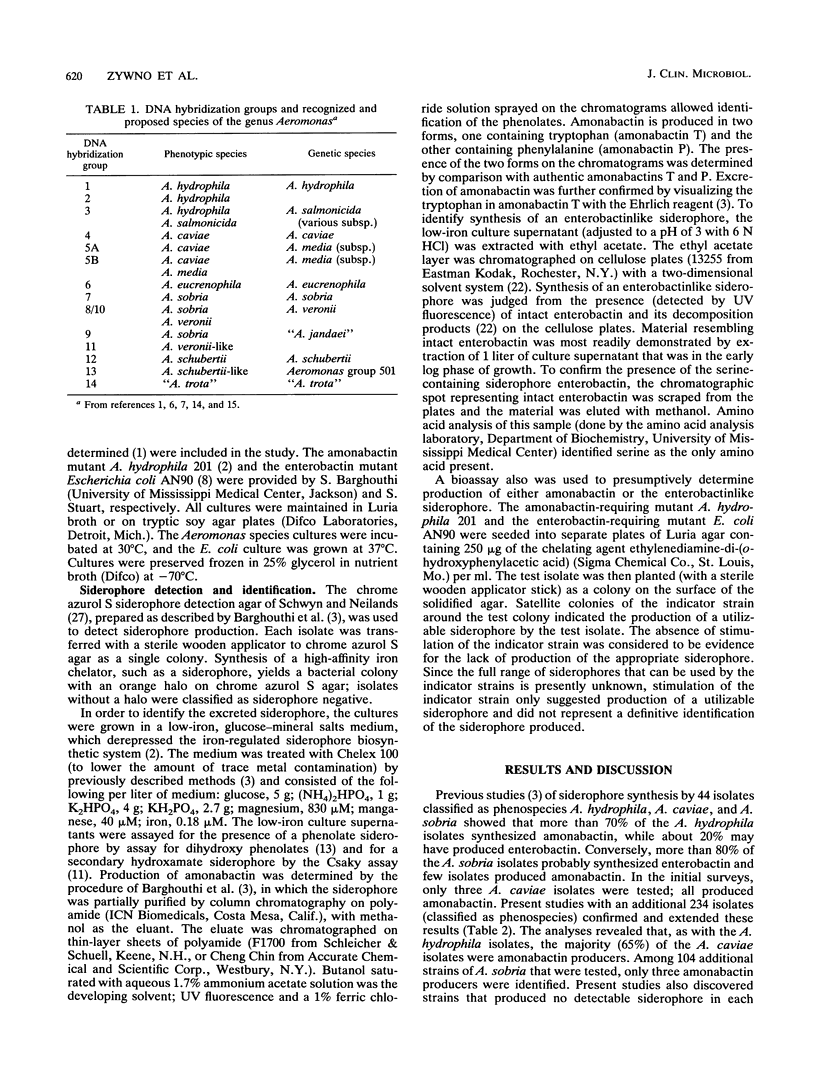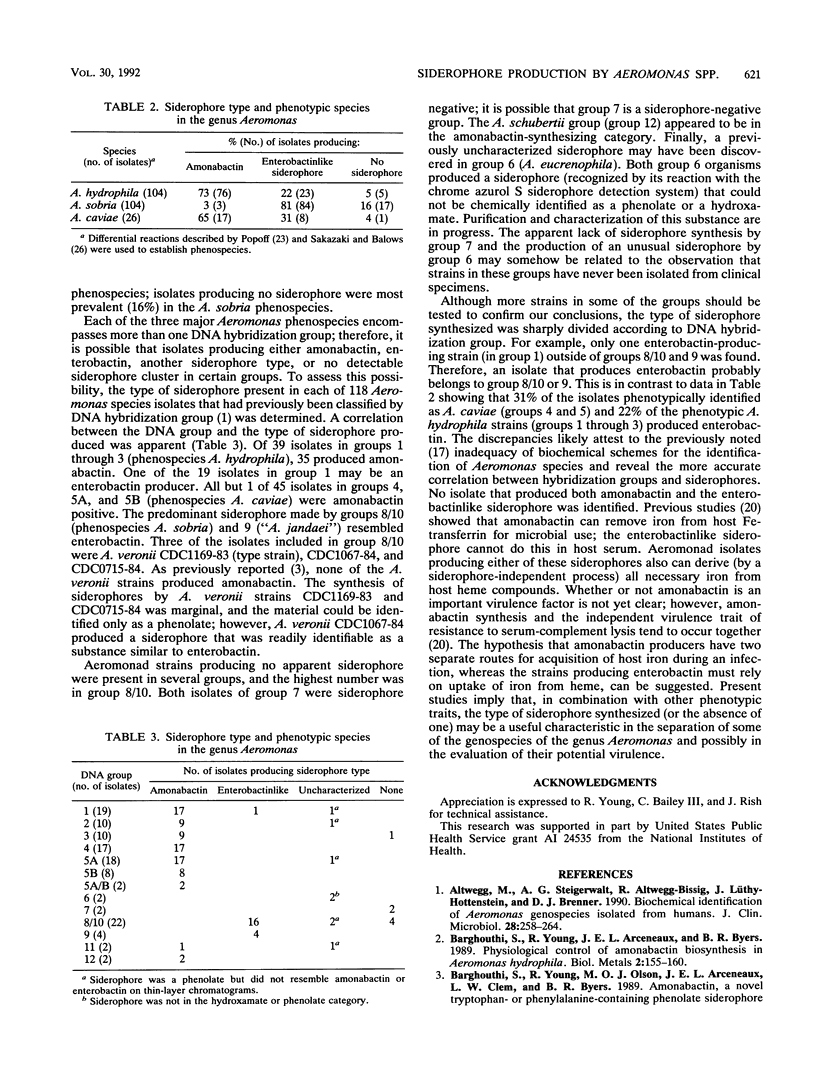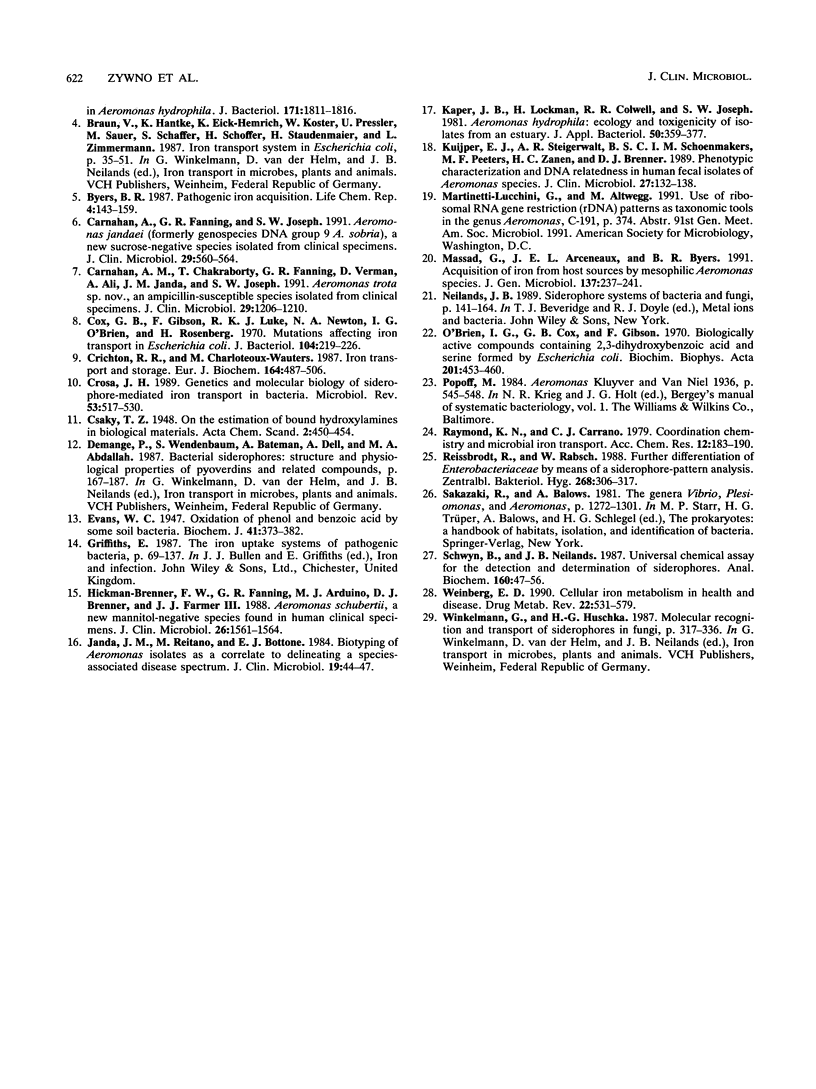Abstract
A correlation between the genospecies (DNA-DNA hybridization group) and the type of siderophore produced by 118 isolates of the genus Aeromonas was established. Organisms in hybridization groups 1 through 5 (including 5A, 5B, and 5AB) and group 12 predominantly produced the siderophore amonabactin, while an enterobactinlike siderophore was prevalent in groups 8/10 and 9. The siderophore produced by strains in group 6 may be an as-yet-unidentified nonphenolate, nonhydroxamate compound, and group 7 isolates synthesized no siderophores. Determination of the indigeneous siderophore (or the absence of one) produced by an isolate of the genus Aeromonas may assist in identification of the organism's genetic species and may suggest the presence of certain virulence properties.
Full text
PDF



Selected References
These references are in PubMed. This may not be the complete list of references from this article.
- Altwegg M., Steigerwalt A. G., Altwegg-Bissig R., Lüthy-Hottenstein J., Brenner D. J. Biochemical identification of Aeromonas genospecies isolated from humans. J Clin Microbiol. 1990 Feb;28(2):258–264. doi: 10.1128/jcm.28.2.258-264.1990. [DOI] [PMC free article] [PubMed] [Google Scholar]
- Barghouthi S., Young R., Arceneaux J. E., Byers B. R. Physiological control of amonabactin biosynthesis in Aeromonas hydrophila. Biol Met. 1989;2(3):155–160. doi: 10.1007/BF01142554. [DOI] [PubMed] [Google Scholar]
- Carnahan A. M., Chakraborty T., Fanning G. R., Verma D., Ali A., Janda J. M., Joseph S. W. Aeromonas trota sp. nov., an ampicillin-susceptible species isolated from clinical specimens. J Clin Microbiol. 1991 Jun;29(6):1206–1210. doi: 10.1128/jcm.29.6.1206-1210.1991. [DOI] [PMC free article] [PubMed] [Google Scholar]
- Carnahan A., Fanning G. R., Joseph S. W. Aeromonas jandaei (formerly genospecies DNA group 9 A. sobria), a new sucrose-negative species isolated from clinical specimens. J Clin Microbiol. 1991 Mar;29(3):560–564. doi: 10.1128/jcm.29.3.560-564.1991. [DOI] [PMC free article] [PubMed] [Google Scholar]
- Cox G. B., Gibson F., Luke R. K., Newton N. A., O'Brien I. G., Rosenberg H. Mutations affecting iron transport in Escherichia coli. J Bacteriol. 1970 Oct;104(1):219–226. doi: 10.1128/jb.104.1.219-226.1970. [DOI] [PMC free article] [PubMed] [Google Scholar]
- Crichton R. R., Charloteaux-Wauters M. Iron transport and storage. Eur J Biochem. 1987 May 4;164(3):485–506. doi: 10.1111/j.1432-1033.1987.tb11155.x. [DOI] [PubMed] [Google Scholar]
- Crosa J. H. Genetics and molecular biology of siderophore-mediated iron transport in bacteria. Microbiol Rev. 1989 Dec;53(4):517–530. doi: 10.1128/mr.53.4.517-530.1989. [DOI] [PMC free article] [PubMed] [Google Scholar]
- Evans W. C. Oxidation of phenol and benzoic acid by some soil bacteria. Biochem J. 1947;41(3):373–382. doi: 10.1042/bj0410373. [DOI] [PMC free article] [PubMed] [Google Scholar]
- Hickman-Brenner F. W., Fanning G. R., Arduino M. J., Brenner D. J., Farmer J. J., 3rd Aeromonas schubertii, a new mannitol-negative species found in human clinical specimens. J Clin Microbiol. 1988 Aug;26(8):1561–1564. doi: 10.1128/jcm.26.8.1561-1564.1988. [DOI] [PMC free article] [PubMed] [Google Scholar]
- Janda J. M., Reitano M., Bottone E. J. Biotyping of Aeromonas isolates as a correlate to delineating a species-associated disease spectrum. J Clin Microbiol. 1984 Jan;19(1):44–47. doi: 10.1128/jcm.19.1.44-47.1984. [DOI] [PMC free article] [PubMed] [Google Scholar]
- Kaper J. B., Lockman H., Colwell R. R., Joseph S. W. Aeromonas hydrophila: ecology and toxigenicity of isolates from an estuary. J Appl Bacteriol. 1981 Apr;50(2):359–377. doi: 10.1111/j.1365-2672.1981.tb00900.x. [DOI] [PubMed] [Google Scholar]
- Kuijper E. J., Steigerwalt A. G., Schoenmakers B. S., Peeters M. F., Zanen H. C., Brenner D. J. Phenotypic characterization and DNA relatedness in human fecal isolates of Aeromonas spp. J Clin Microbiol. 1989 Jan;27(1):132–138. doi: 10.1128/jcm.27.1.132-138.1989. [DOI] [PMC free article] [PubMed] [Google Scholar]
- Massad G., Arceneaux J. E., Byers B. R. Acquisition of iron from host sources by mesophilic Aeromonas species. J Gen Microbiol. 1991 Feb;137(2):237–241. doi: 10.1099/00221287-137-2-237. [DOI] [PubMed] [Google Scholar]
- O'Brien I. G., Cox G. B., Gibson F. Biologically active compounds containing 2,3-dihydroxybenzoic acid and serine formed by Escherichia coli. Biochim Biophys Acta. 1970 Mar 24;201(3):453–460. doi: 10.1016/0304-4165(70)90165-0. [DOI] [PubMed] [Google Scholar]
- Reissbrodt R., Rabsch W. Further differentiation of Enterobacteriaceae by means of siderophore-pattern analysis. Zentralbl Bakteriol Mikrobiol Hyg A. 1988 May;268(3):306–317. doi: 10.1016/s0176-6724(88)80015-4. [DOI] [PubMed] [Google Scholar]
- Schwyn B., Neilands J. B. Universal chemical assay for the detection and determination of siderophores. Anal Biochem. 1987 Jan;160(1):47–56. doi: 10.1016/0003-2697(87)90612-9. [DOI] [PubMed] [Google Scholar]
- Weinberg E. D. Cellular iron metabolism in health and disease. Drug Metab Rev. 1990;22(5):531–579. doi: 10.3109/03602539008991450. [DOI] [PubMed] [Google Scholar]


